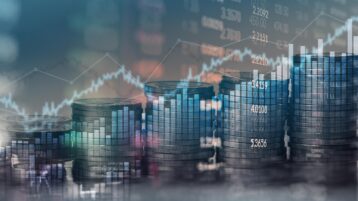Most S&P 500 companies have reported earnings that have beat expectations in this latest quarter. Damian Fernandes, Managing Director and Portfolio Manager at TD Asset Management, explains why the results suggest investors shouldn’t be too bearish on stocks going forward.
Print Transcript
[AUDIO LOGO]
While companies have largely delivered positive earnings results this quarter, many have also provided some guidance that suggests there could be some tough days ahead. So what does it mean for the market and the opportunities going forward? Joining us now to discuss, Damian Fernandes, Managing Director and Portfolio Manager at TD Asset Management. Damian, great to have you back on the show.
Always a pleasure, Craig. Let's start with earnings season. What are you seeing? What's it telling us about the road ahead?
Yeah, the road ahead. It's less bad than feared. All right, think about this for a second. We've spent the last 18 months and everyone's been expecting a recession and we've been calling for an economic recession-- a slowdown --and it's been doom and gloom.
We had that in earnings, in US earnings. They didn't have a recession. You've had 3/4-- about Q4 last year, Q1 this year, Q2 this year-- earnings were negative on a year-on-year basis. So you had, practically speaking, earnings recession.
Better than feared was my prognosis because Q3, this is going to be the first quarter since last year where earnings have inflected up. They're positive. And like most things with momentum, as these things start they continue.
So the headline numbers aren't a barn burner. Revenues are up 2%, earnings are a little up more than that. But when you look under the surface-- if you take out things like energy-- I should start by saying this.
We have close to 90% of companies reported. So it's pretty much, we know what the end is going to be like. And if you take out energy stocks and materials stocks, earnings are actually up close to 10%-- like 9%. Revenues are up close to five. So a lot of good things under the surface.
And the reason why I excluded energy is because last year energy earnings were buoyed by geopolitical risk-- really high energy prices. So the comp this year just makes it difficult. But look, even including energy we've inflected positive. And when you look at the history of earnings, they continue to do so until interrupted.
So the fact that we've inflected positive, if we have a softish landing, if we don't collapse into an economic recession-- coming out of this earnings recession that'll be good. And I think that's generally when-- earnings are ultimately the driver of stock returns, and if they've inflected positive, that's probably a sign that we shouldn't be too bearish on stocks going forward.
Let's talk about some examples from earnings season. So let's take away energy, let's put away materials, but let's take a look at Big Tech-- Meta and some of the other firms. What were you seeing out there?
Oh my, when you think about the Magnificent Seven-- right, the moniker that people use --it is well deserved for a certain degree. The Magnificent Seven came out with magnificent earnings. The stock prices were already pricing a lot of that in-- so the stock prices were moving ahead. But you talked about Meta-- use something like Meta as the top line.
So revenues at Meta were up 25%, earnings were up over 100 year-on-year. So the difference, obviously, is that Meta in this last year seeing this slowdown coming, they actually took steps. They lowered their CapEx-- so they cut CapEx by about $3 billion. So that meant free cash flow-- what ultimately drives value for the business, that improved.
They cut expenses. We've heard about changes to their workforce, they've laid off a lot of people. So they actually front, almost in anticipation of a slowdown-- an economic slowdown --they took steps. The slowdown didn't materialize, revenues are up 25%, so you have this massive operating leverage.
Not just Meta, but even more conventional companies. Microsoft, right? Microsoft is reporting 13% top line growth, I think like 25% plus EPS growth, and that's even before it's implementing its AI offering, Copilot. All of us with Microsoft will have our own AI assistant. That's before this.
They're already reporting Amazon, really good numbers there. Amazon reported its AWS-- its cloud business --that was up 12%. I found something really interesting in Amazon's numbers. So when we think of Amazon, we obviously think about cloud, and then we think about conventional retail.
The Amazon e-commerce site. Amazon's e-commerce in North America, the margins there are close to 5%. That's in line with Walmart. Amazon, which has this huge logistics platform, which you can have stuff delivered to your store, it's earning basically the same profitability as you and I walking into a Walmart store and picking up off the shelf. These things are-- when you talk about-- I find the moniker sometimes is misleading and people like to pick on winners. But to be clear--
I wanted to ask you that. I'm going to pick on the winners a little bit. We've been showing one year stock charts. They've gone up quite a bit. Markets are forward looking instrument. I mean have they had their run, even though they have had, as you said these solid results?
These stock charts are manifestation of the underlying fundamentals, right? When people look at stock charts, they love charts that go from the bottom left to the top right. But generally the stocks, unless we're in almost a market where investor sentiment is really aggressive, the reason stock prices go from the bottom left to the top right is because fundamentals are improving. When you have companies delivering double digit revenue growth and high double-- 20% plus EPS and cash flow growth, that's the stock price.
So the better question is-- and I think what you're getting to-- have they have had their day in the sun? They've all come out with guidance that has been generally I would say conservative. So if they keep beating and raising the stock prices should continue doing well.
What's more interesting for these companies is in the case of names like Meta, is regulatory risk? Do the regulations or the regulatory backdrop around providing advertising services through social media, do the regulators finally-- those things which are existential and I can't price. But the actual core businesses are doing fine.
Let's talk about the big overhangs for the market then if we're looking at the fundamentals, which we do during an earnings season. Companies earnings their way based on their merits. But inflation, the economy, rate hikes everything that's been dominating the conversation for a year and a half. Where do we feel we are in that story? A lot of people want to put behind this obviously.
Yeah, it's not even-- before it was the hope of inflation, of really aggressive rate hikes, of a slowdown. There was the hope that these things will eventually be behind us. We are seeing at least-- we're at the end of-- I've said that I think the Feds done. The Feds been done since July, they haven't raised rates since July similar to the Bank of Canada.
The last week, what I found really interesting was that the Federal-- either Jerome Powell and you've had communications from Fed board members-- they're talking about how the recent increase in long term rates has tightened financial conditions, basically done the job for them. They want to make things more-- they want to increase the price of money, make it more expensive, interest costs rising.
And they do that by raising short term rates, but the long term rates have risen up more so. And you've tightened financial conditions-- and by the way, while this is happening inflation is coming lower. We had a jobs number last week that was-- in my mind, almost Goldilocks. It was still positive, but it wasn't too hot, it wasn't too--
There were Americans who did get jobs but not too many Americans--
Not too many Americans got jobs. The wage numbers weren't too hot, so you're seeing evidence that we're at the end of this rate hiking campaign. That inflation is going to slow and will continue to slow over the next few months. If inflation continues to slow, you could actually have rate cuts, because the current rate hiking environment is too tight.
And so these things that-- let's put it this way. The reason investors reached for-- had indigestion last year, reached for the Pepto-Bismol was because of aggressive rate hikes, was because inflation was at the fastest level since the 70s. We're on the other side of that mountain. Inflation's is falling, it looks like rates have peaked and might come down in the next-- that's what the market's pricing in. These macro variables are positive. As long as-- I should have a provision here, right?
Yeah, there's always a buzz. What if?
The thing that we're looking for is-- People talk about soft landing, hard landing-- would we want a slow down or no landing? What we really want is, you can afford a mediocre recession or a slowdown. The difference between minus 1 and plus 0.5% is literally-- what we don't want is a much more significant slowdown. We don't want the current rate hikes that have put in place to actually lead to a significant credit event that actually weighs on the consumer.
So if we have a softish landing, or a mild slowdown, a mild recession, things will be fine. The market's already priced for that. What the market has in priced for is a much more deeper recession and look, to be clear, where I stand today. I don't-- looking at the variables I look at-- I don't know if we have enough evidence to say that things are going to be materially worse. Things are going to slow for sure. Q4 will be slower than Q3. So that's just my view. [AUDIO LOGO]
[MUSIC PLAYING]
While companies have largely delivered positive earnings results this quarter, many have also provided some guidance that suggests there could be some tough days ahead. So what does it mean for the market and the opportunities going forward? Joining us now to discuss, Damian Fernandes, Managing Director and Portfolio Manager at TD Asset Management. Damian, great to have you back on the show.
Always a pleasure, Craig. Let's start with earnings season. What are you seeing? What's it telling us about the road ahead?
Yeah, the road ahead. It's less bad than feared. All right, think about this for a second. We've spent the last 18 months and everyone's been expecting a recession and we've been calling for an economic recession-- a slowdown --and it's been doom and gloom.
We had that in earnings, in US earnings. They didn't have a recession. You've had 3/4-- about Q4 last year, Q1 this year, Q2 this year-- earnings were negative on a year-on-year basis. So you had, practically speaking, earnings recession.
Better than feared was my prognosis because Q3, this is going to be the first quarter since last year where earnings have inflected up. They're positive. And like most things with momentum, as these things start they continue.
So the headline numbers aren't a barn burner. Revenues are up 2%, earnings are a little up more than that. But when you look under the surface-- if you take out things like energy-- I should start by saying this.
We have close to 90% of companies reported. So it's pretty much, we know what the end is going to be like. And if you take out energy stocks and materials stocks, earnings are actually up close to 10%-- like 9%. Revenues are up close to five. So a lot of good things under the surface.
And the reason why I excluded energy is because last year energy earnings were buoyed by geopolitical risk-- really high energy prices. So the comp this year just makes it difficult. But look, even including energy we've inflected positive. And when you look at the history of earnings, they continue to do so until interrupted.
So the fact that we've inflected positive, if we have a softish landing, if we don't collapse into an economic recession-- coming out of this earnings recession that'll be good. And I think that's generally when-- earnings are ultimately the driver of stock returns, and if they've inflected positive, that's probably a sign that we shouldn't be too bearish on stocks going forward.
Let's talk about some examples from earnings season. So let's take away energy, let's put away materials, but let's take a look at Big Tech-- Meta and some of the other firms. What were you seeing out there?
Oh my, when you think about the Magnificent Seven-- right, the moniker that people use --it is well deserved for a certain degree. The Magnificent Seven came out with magnificent earnings. The stock prices were already pricing a lot of that in-- so the stock prices were moving ahead. But you talked about Meta-- use something like Meta as the top line.
So revenues at Meta were up 25%, earnings were up over 100 year-on-year. So the difference, obviously, is that Meta in this last year seeing this slowdown coming, they actually took steps. They lowered their CapEx-- so they cut CapEx by about $3 billion. So that meant free cash flow-- what ultimately drives value for the business, that improved.
They cut expenses. We've heard about changes to their workforce, they've laid off a lot of people. So they actually front, almost in anticipation of a slowdown-- an economic slowdown --they took steps. The slowdown didn't materialize, revenues are up 25%, so you have this massive operating leverage.
Not just Meta, but even more conventional companies. Microsoft, right? Microsoft is reporting 13% top line growth, I think like 25% plus EPS growth, and that's even before it's implementing its AI offering, Copilot. All of us with Microsoft will have our own AI assistant. That's before this.
They're already reporting Amazon, really good numbers there. Amazon reported its AWS-- its cloud business --that was up 12%. I found something really interesting in Amazon's numbers. So when we think of Amazon, we obviously think about cloud, and then we think about conventional retail.
The Amazon e-commerce site. Amazon's e-commerce in North America, the margins there are close to 5%. That's in line with Walmart. Amazon, which has this huge logistics platform, which you can have stuff delivered to your store, it's earning basically the same profitability as you and I walking into a Walmart store and picking up off the shelf. These things are-- when you talk about-- I find the moniker sometimes is misleading and people like to pick on winners. But to be clear--
I wanted to ask you that. I'm going to pick on the winners a little bit. We've been showing one year stock charts. They've gone up quite a bit. Markets are forward looking instrument. I mean have they had their run, even though they have had, as you said these solid results?
These stock charts are manifestation of the underlying fundamentals, right? When people look at stock charts, they love charts that go from the bottom left to the top right. But generally the stocks, unless we're in almost a market where investor sentiment is really aggressive, the reason stock prices go from the bottom left to the top right is because fundamentals are improving. When you have companies delivering double digit revenue growth and high double-- 20% plus EPS and cash flow growth, that's the stock price.
So the better question is-- and I think what you're getting to-- have they have had their day in the sun? They've all come out with guidance that has been generally I would say conservative. So if they keep beating and raising the stock prices should continue doing well.
What's more interesting for these companies is in the case of names like Meta, is regulatory risk? Do the regulations or the regulatory backdrop around providing advertising services through social media, do the regulators finally-- those things which are existential and I can't price. But the actual core businesses are doing fine.
Let's talk about the big overhangs for the market then if we're looking at the fundamentals, which we do during an earnings season. Companies earnings their way based on their merits. But inflation, the economy, rate hikes everything that's been dominating the conversation for a year and a half. Where do we feel we are in that story? A lot of people want to put behind this obviously.
Yeah, it's not even-- before it was the hope of inflation, of really aggressive rate hikes, of a slowdown. There was the hope that these things will eventually be behind us. We are seeing at least-- we're at the end of-- I've said that I think the Feds done. The Feds been done since July, they haven't raised rates since July similar to the Bank of Canada.
The last week, what I found really interesting was that the Federal-- either Jerome Powell and you've had communications from Fed board members-- they're talking about how the recent increase in long term rates has tightened financial conditions, basically done the job for them. They want to make things more-- they want to increase the price of money, make it more expensive, interest costs rising.
And they do that by raising short term rates, but the long term rates have risen up more so. And you've tightened financial conditions-- and by the way, while this is happening inflation is coming lower. We had a jobs number last week that was-- in my mind, almost Goldilocks. It was still positive, but it wasn't too hot, it wasn't too--
There were Americans who did get jobs but not too many Americans--
Not too many Americans got jobs. The wage numbers weren't too hot, so you're seeing evidence that we're at the end of this rate hiking campaign. That inflation is going to slow and will continue to slow over the next few months. If inflation continues to slow, you could actually have rate cuts, because the current rate hiking environment is too tight.
And so these things that-- let's put it this way. The reason investors reached for-- had indigestion last year, reached for the Pepto-Bismol was because of aggressive rate hikes, was because inflation was at the fastest level since the 70s. We're on the other side of that mountain. Inflation's is falling, it looks like rates have peaked and might come down in the next-- that's what the market's pricing in. These macro variables are positive. As long as-- I should have a provision here, right?
Yeah, there's always a buzz. What if?
The thing that we're looking for is-- People talk about soft landing, hard landing-- would we want a slow down or no landing? What we really want is, you can afford a mediocre recession or a slowdown. The difference between minus 1 and plus 0.5% is literally-- what we don't want is a much more significant slowdown. We don't want the current rate hikes that have put in place to actually lead to a significant credit event that actually weighs on the consumer.
So if we have a softish landing, or a mild slowdown, a mild recession, things will be fine. The market's already priced for that. What the market has in priced for is a much more deeper recession and look, to be clear, where I stand today. I don't-- looking at the variables I look at-- I don't know if we have enough evidence to say that things are going to be materially worse. Things are going to slow for sure. Q4 will be slower than Q3. So that's just my view. [AUDIO LOGO]
[MUSIC PLAYING]



























